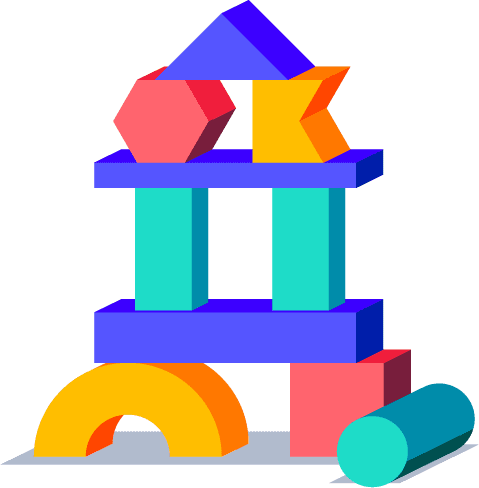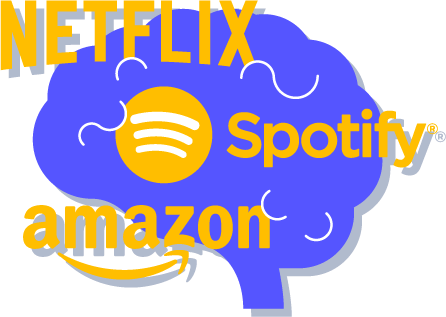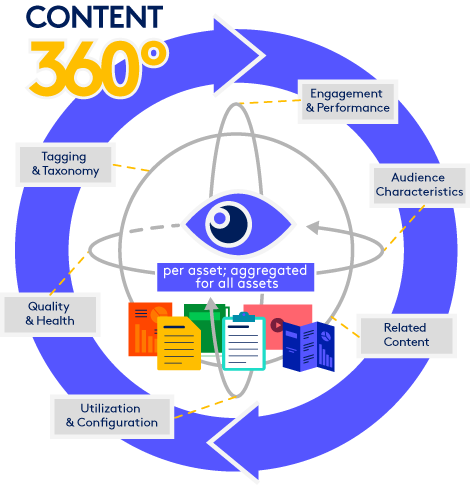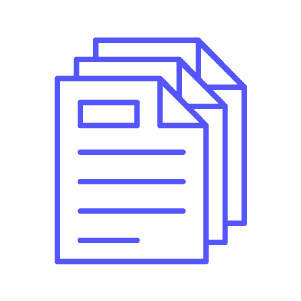Go Beyond The Email Drip Campaign: How To Level-Up Your Nurture Strategy
Here you’ll learn the building blocks of Content Intelligence, become comfortable with essential terminology, and learn how to radically transform your marketing programs.

Driven by Digital Transformation
Ever since Digital Transformation was popularized over a decade ago, B2B organizations have been in a state of seemingly perpetual transformation, lagging behind changes to consumer behavior thanks to services like Netflix, Spotify, or Amazon in the personal lives of B2B buyers. While the expectations of digital business as the new normal were starting to shift away from a state of constantly transforming, the biggest shift happened in 2020 when essentially the entire world changed the way they did business overnight.

The way that digital transformation was and still is defined varies greatly by industry, organization, and by department and job title. For marketers, digital transformation and, ultimately, the ability for organizations to fully embrace digital business, isn’t possible without delivering the right content to the right person at the right time, and enabling them to make a buying decision for themselves or their organization. With this strategic shift, most companies are just beginning to make the proper investments in people, process, and technology needed to be successful; they haven’t tackled implementation yet. That’s where Content Intelligence comes in.
Content Intelligence is a cross-functional effort across the entire marketing organization – from the CMO to the marketing coordinator, demand gen, digital, content, operations, and everyone in between – so it’s essential for marketers to have a common understanding of the terminology as you start to explore and implement this strategy. CMOs play a key role in leading their companies’ customer experience, digital transformation, and data strategies, and have to work fast to turn brand awareness into revenue. With Content Intelligence they are able to unlock valuable insights that are unavailable via traditional means and fuel the digital experiences they need the team to create at scale. As it becomes mainstream, being hip to the terminology used to discuss strategies, tactics, engagement, activation, measurement, and effectiveness of Content Intelligence means every marketer on the team has to know the popular phrases and terms. This eBook contains a glossary of defined terms, many of which may be familiar from prior research.
Content Intelligence Defined
Forrester defines Content Intelligence as: “technology that helps content understand itself – what it’s about, how it speaks, how effective it is at accomplishing certain goals, what emotions it calls to mind, etc.” From Wikipedia, it’s described as: “a strategy that uses artificial intelligence systems and software to process content data into reliable insights about the effectiveness of a business’ content.” The definitions vary greatly from leading research companies to industry thought leaders.
As the leading technology provider of Content Intelligence, at PathFactory, we refined our definition to align to a B2B content marketing strategy and define it as:
Content Intelligence provides a 360-degree view of an organization’s content and its attributes, generating insights, informing content strategy, and delivering the best content experiences possible.
Value & Benefits of Content Intelligence

Much like Digital Transformation, Content Intelligence isn’t a single action done once, nor is it a static measurement of marketing KPIs, but rather a continual state of gathering insights, reviewing strategy, and execution. It’s dynamic and evolves as the marketing team produces more content, runs more campaigns to drive traffic and engagement, and replicates high-performing programs.

True Content Intelligence enables actionable insights previously unattainable and delivers a 360-view of a content asset to provide the marketer all of the knowledge they would need to drive success. Using AI-powered technology, data can be utilized to scale these programs and target each individual with personalized experiences. With Content Intelligence, your content is relevant across all touchpoints.
Content Intelligence transforms a marketing department by enabling them to:
Determine what’s working – and exploit it.
You can increase content engagement time by 5-10X and reduce overall bounce rates.
Elevate and Personalize effective content.
With hyper-targeting to key buyer personas, content sessions can be 3-6X longer.
Eliminate redundant and underperforming content.
Obtain a thorough understanding of your entire content library and the attributes for an individual asset with data-driven insights.
Deliver relevant experiences at scale.
Successfully position a content strategy to evolve and scale without heavy manual effort.
Content Intelligence in Action
Harvard Business Review states that “Digital Transformation is a combination of technology, data, process, and organizational change.” Similarly, capitalizing on Content Intelligence means changes to your technology, data, process, and people.
In the context of marketing use cases, companies can choose to start small or take on a bigger challenge by tackling the entire initiative head-on. The use cases below outline various actions that can be taken as a marketing team implements Content Intelligence to improve upon key focus areas.
Here are the top use cases that can be radically transformed with Content Intelligence and the actions that can be taken to see results.
Content Strategy —
Align your content and assets to your marketing goals
- Conduct a health check for all content assets
- Combine key marketing and business topics with AI to understand what content really speaks to your organization’s mission and strategic direction
- Surface and identify content gaps and compliance for SEO, accessibility and overall corporate alignment
- Improve and streamline your content strategy and development process
Web Conversion —
Deliver contextually relevant recommendations and content experiences
- Segment by industry, funnel stage, buyer persona, and more
- Align content to trending topics or new announcements
- Move unknown visitors to known engagers with tracking, AI, and analytics
Account-Based Marketing (ABM) —
Achieve content personalization at scale
- Auto-generate targeted content recommendations at every stage of the buyer and customer journey
- Enable content self-service with both gated and ungated offers
- Align content to organization through data and analytics
- Automate content recommendations across channels
Nurture —
Accelerate content consumption with personalization and targeting
- Encourage content bingeing with smart grouping of assets
- Maximize nurture ability by combining your content and ABM strategies to measure and track success
- Deliver targeted content for known and unknown inbound visitors based on previous actions and search terms
- Easily duplicate content tracks and tweak where needed
Enablement —
Ensure all audiences are given the knowledge they need to succeed
- Tag content for key groups (both internal and external) such as: sales, support, customers, and partners
- Group and share content by knowledge level and measure engagement for both technical and business-focused teams
- Create targeted content tracks, define access parameters, and report on use
- Easily communicate on announcements, new products or solutions, major changes, and more
The use cases outlined above often involve multiple marketing roles. When team members are briefed and aligned, all areas are covered and projects keep moving. Even better, incorporate Content Intelligence initiatives into objectives and key results (OKRs) as part of the marketing strategy. Making these use cases and actions part of the team’s regular responsibilities – and building a better content dashboard to track progress against your goals – will ensure greater success.
Content Intelligence Vocabulary

In order to be smart about Content Intelligence, there are some essential words and phrases to educate yourself on in order to better understand your content and clearly communicate your strategy and plan. Additionally, in order to successfully advocate for, implement, and track success for your content strategy, understanding of these terms and how to apply them to your unique business requirements is essential.
Content Intelligence transforms a marketing department by enabling them to:

Strategy

Activation

Engagement

Science
In order to be smart about Content Intelligence, there are some essential words and phrases to educate yourself on in order to better understand your content and clearly communicate your strategy and plan. Additionally, in order to successfully advocate for, implement, and track success for your content strategy, understanding of these terms and how to apply them to your unique business requirements is essential.
Strategic Terminology
The first step to leveraging Content Intelligence successfully is to understand the current state of your content and how it aligns to your marketing goals. Once you’ve gained an extensive understanding – often involving a complete content audit and analysis of what’s working – you can start to plan and determine what to measure once you get started.

Content Audit
The process of systematically reviewing all digital content and assets you have, whether published or private. A thorough audit will determine what content exists, which key business topics it aligns to, how people can find it, how it is performing, and if it’s current, accurate, or outdated.
—
Content ROI
The calculation of how well a content asset (or a group of content assets in a campaign) performed based on how much pipeline and revenue was generated after its activation.
—
Content Corpus
A library of content across all channels that can be analyzed, including content created by a third party.
—
Key Marketing Topics
A range of topics that align to a company’s go-to-market strategy. Examples include: business focus areas, industries, product names, SEO/SEM strategies, personas, and other key words and phrases that your content should be an authority on.
—

Smart Content
The first step to leveraging Content Intelligence successfully is to understand the current state of your content and how it aligns to your marketing goals. Once you’ve gained an extensive understanding – often involving a complete content audit and analysis of what’s working – you can start to plan and determine what to measure once you get started.
—
Key Phrases
Similar to a keyword, a set of separate words or simple descriptors that becomes a phrase people use to organize, sort, search, and group content together.
—
Rich Content
Content containing media that involves sound, images, and video. Some examples of rich content are static images, animated GIFs, videos, and audio clips.
—
Taxonomy
The identification and classification of content into a hierarchical structure so that it can be used and distributed in multiple ways. This is done by manual analysis, AI-driven analysis, or a hybrid of the two.
—
Topics
Generated by clustering related keywords and key phrases together to create stronger correlation, context, and to compare against other topics, or topic themes. They can then be used to group content assets together.
—
Topic Modeling
The process that allows us to understand the relationship between the assets grouped in a content taxonomy.
—
Topic Analysis
The process by which you create a topic model.
—
Topic Signature
A set of related words (much like the ingredients in a recipe) that best represent a content asset or group of assets.
—
Topic Themes
The overarching categories that encompass topics and the grouped content assets that sit underneath each topic.
—
Activation Terminology
Activating your content across the right channels effectively means making sure you reach the right people at the right time in the right channel, and with the right asset. Featured content assets such as large eBooks, visually stunning infographics, or expensive analyst reports will not perform to expectations if they do not exist in the ideal places, or if they are unnecessarily gated. Using ABM or similar approaches to content targeting, even meatier assets can be ungated, increasing consumption without losing data on the consumer.

Content Analysis
Combining both quantitative and qualitative approaches, content analysis is used to identify patterns across all content assets or a subset of those assets. Can be done manually, with AI, or a hybrid approach.
—
Content Data
Any data whether in digital, or other form (including metadata) that conveys the information, meaning, purpose, intent, or intelligence of the content asset.
—
Content Syndication
Publishing, replicating, renting or purchasing space where the same piece of content is shown in additional places beyond the original location. A common example is when a 3rd party site publishes a piece of content originally published on a corporate website.
—
Self-Directed Experiences
Content-led growth that allows the consumer to take charge of their own research and digital experience. Often designed to be personalized, users can interact with content at their own pace that is auto-generated based on prior interest, known facts, or actions taken.
—

Document ID
A unique code generated for each piece of digital content that provides an easy way to track the assets regardless of location.
—
Meta Tags
An area within the HTML code of a website that describes the contents of a specific web page and is used by search engines to index pages by subject.
—
Omnichannel
A method used to deliver a consistent, connected user experience across all brand platforms and channels. An example would be to ensure brand uniformity across your corporate website, mobile app, and physical locations.
—
Engagement Terminology
The best produced and most well-written content is useless if it’s not interesting to your audience. Delivering the right content to the right person at the right time can increase consumption rates and better target the roles and buyers that your sales teams want to engage with. The more you know about the topics or themes your audience is actively engaged in, the better your campaigns will perform when aligned.

Content Consumption
The act of engaging with content, whether by reading, watching, listening, etc. and often measured in length of time spent or number of consumers.
—
Content Engagement
Content engagement tracks users’ actions when interacting with digital assets to measure how relevant it was.
—
Content Performance
A method to measure the impact that content has to one or more target audiences.
—
Content Score
A predictive measurement of the competitiveness, relevancy, and coverage of digital content.
—
Channel Performance
An outcome measurement of the distribution channel. Channels can be assessed by considering a number of performance metrics, including effectiveness, efficiency, productivity, and profitability. In the case of Content Intelligence, marketers may look at the quantity of visits from a specific channel as well as the quality of the audience and their engagement.
—

Content Session
A set of multiple content interactions by a visitor that take place within a given time frame.
—
Content Waste
Content produced that is never published, or is neglected in internal repositories.
—
Attribution
The analytical practice of determining which content, campaigns, and channels are contributing to pipeline and revenue. This is typically done by evaluating the marketing touchpoints a buyer encounters on the journey that results in a purchase.
—
Lift Analysis
A way to measure how a campaign impacts a key metric, such as engagement or conversion. Lift is calculated as the percentage increase or decrease in the key metric you’re measuring.
—
Binge Rate
The percentage of visitors that have consumed more than one asset in a single session. Someone is considered a ‘binger’ as soon as the page loads on the second asset.
—

Content Binger
A visitor that consumes more than one content asset in a single session.
—
Content Bouncer
A user that exits a session after viewing only one asset or before viewing any assets.
—
Session
A set amount of time in which a visitor interacts with multiple content assets.
—
Scientific Terminology
True Content Intelligence cannot exist without the help of technology and science. Artificial intelligence and other related methods automate major functionality so that you can deliver personalized content at scale. When measuring success, the insights surfaced through data analysis provide a much deeper level of knowledge and understanding of content that will increase your campaign performance over time.

Artificial Intelligence (AI)
The simulation of human intelligence demonstrated by machines, especially computer systems.
—

Collaborative Filtering
Used to identify the similarities between users and content (such as preferences) to perform automated recommendations.
—
Data Science
A concept comprising many fields including mathematics and computer science, it unifies statistics, data analysis, and related methods in order to understand and analyze data and information.
—
Machine Learning (ML)
A form of AI, machine learning is technology that has been designed to learn and adapt without being explicitly programmed to do so by using algorithms and statistical models to analyze and identify patterns in data.
—
Natural Language Processing (NLP)
A form of AI, natural language processing allows machines to read and interpret human language.
—
AI-Generated Taxonomy
The use of software programs and natural language processing (NLP) to generate a hierarchical classification from a corpus.
—
Ontology
A method used to define the key words and phrases that would best represent the key concepts you’re trying to communicate with your content. Can be done manually or with AI.
—
Optical Character Recognition (OCR)
Also known as optical character reader or referred to as text recognition, it is the use of technology to distinguish printed or handwritten text characters inside digital images, or to convert images into text.
—
Sentiment
Whether done manually or using AI, it describes the overall tone of an asset, most commonly by summarizing whether it’s positive, negative or neutral.
—
Vector Embedding
The process of using machine learning to group assets together by how similar they are and then displaying those similarities in a visual way. This is done by assigning each content asset a numbered score.
—
Create Your Content Intelligent Future
Driven by Digital Transformation
Now that you’re up to speed on the fundamentals of Content Intelligence, the value and benefits it provides, and its practical applications for key marketing use cases, you can start planning how to turn ideas into action and be a true advocate for Content Intelligence. Adjusting strategy, investing in new technology, realigning team focus, and changing processes are not easy tasks, but being able to clearly outline potential success for even a single use case can be a good place to start.
Consider your website, for example. Are you able to capture information on each visitor, even if they are unknown? Are you serving up content based on the action they took before arriving at your site, whether through Google search, clicking an ad, typing your URL directly, or any of the other countless ways they get there? And if they clicked on an ad, which ad, or which version of an ad that is part of your content syndication campaign? Delivering the right content to the right person at the right time becomes increasingly complicated in an omnichannel world – unless you use Content Intelligence to identify characteristics of each site visitor (whether known or unknown), and deliver relevant content recommendations using AI-based technologies. To ensure you have content that is aligned to what your buyers want, you can also take your key marketing topics and run reports to see what content exists that directly speaks to each marketing topic that exists in your corpus today. Often it’s about quickly being able to recognize what content needs to be modified, retired, or created. In addition, you can also measure your marketing topics and content to the top keywords and terms being searched on and consumed on search engines like Google. Knowing that similar content is available from industry thought leaders, research firms, partners, and maybe most importantly your competitors will provide the insight you need to best position your brand.
Content Intelligence allows your team to focus on high-impact programs, can strengthen key marketing use cases, and improve KPIs.






